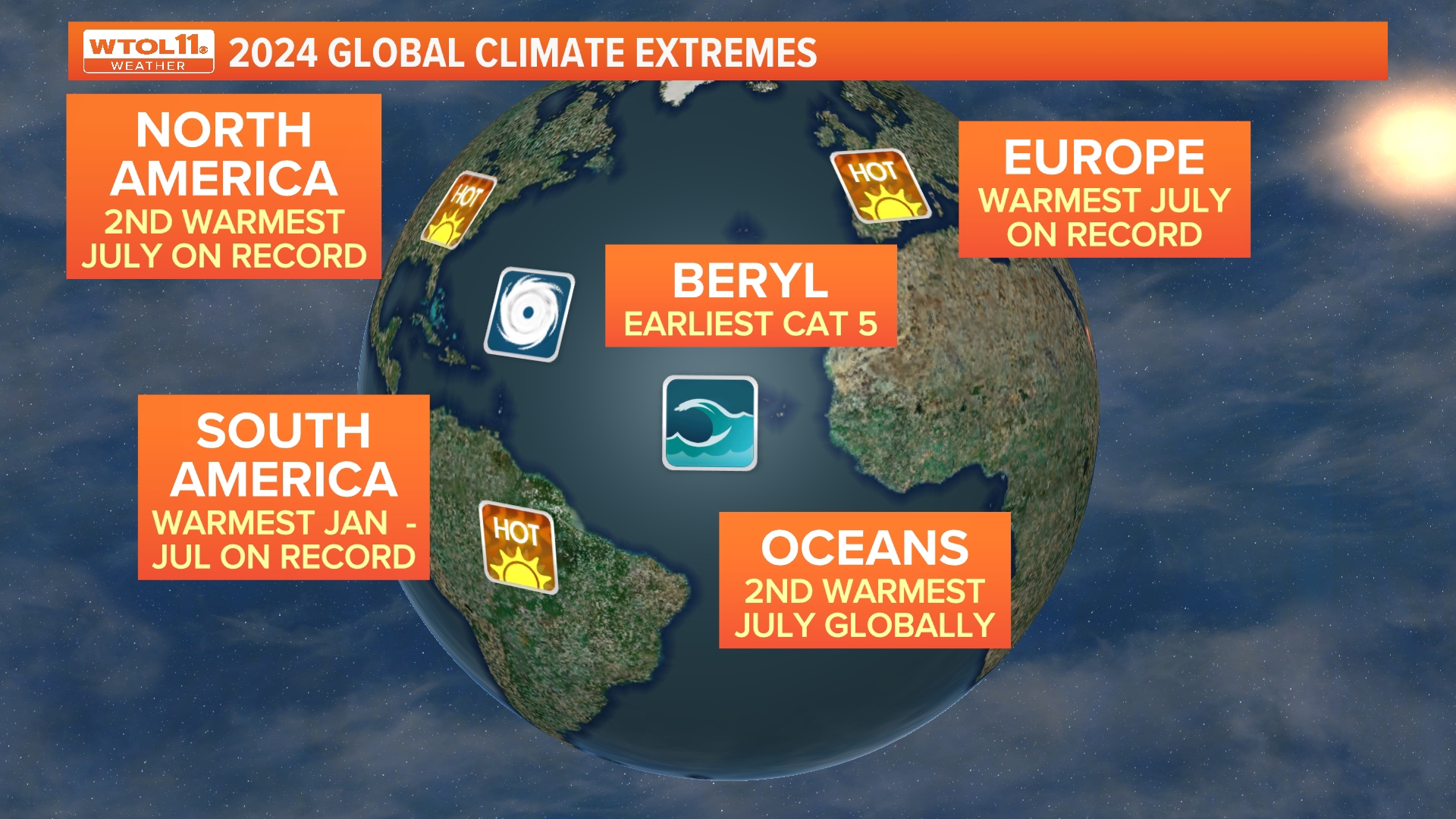TOLEDO, Ohio — Though this summer has felt relatively cool here at home, extreme heat has impacted much of the globe. Following the hottest July on record globally, August is poised to continue a historic streak of record-setting months. In this week's Climate Friday Newsletter, Meteorologist John Burchfield breaks down the broader worldwide trends in summer heat and explains why Ohio and Michigan have felt cooler this season.
While weather describes the day-to-day variations in the weather, climate compiles global data over extended periods, providing a more comprehensive view of changes over time. Weather reflects a snapshot in time, while climate provides an extended timeline. The cooler-than-average weather in Ohio and Michigan is not representative of what much of the world has experienced this summer.
July was the 14th consecutive record-setting warmest month globally, and August is poised to continue this historic streak. While July was several degrees below-average in Toledo, it was 2.18 degrees above-average globally, the warmest ever recorded in 175 years of NOAA weather data.


Not only was July the warmest on record, but it produced the hottest single-day global mean temperature ever recorded. Using Copernicus satellite data, which analyzes ocean and land temperatures globally, including unpopulated areas without weather observation data, NOAA determined that July 22 was the hottest day ever recorded with an average worldwide temperature of 63 degrees.
A number of cities have experienced record single-day temperature extremes this summer. Over 10 countries across the globe have surged over 50 degrees Celsius this summer, or 122 degrees Fahrenheit. A couple historic temperature extremes include: 129 degrees in Death Valley, California; 126 degrees in Tepache, Mexico; 123 degrees in Agadir, Morocco; 123 degrees in Hassi Messaoud, Algeria; 128 degrees in Jahra, Kuwait; 126 degrees in Sanbao, China; 123 degrees in Churu, India.


These extreme high temperatures have contributed to a globally historic summer that will likely go down as the hottest on record. Weather extremes across the globe provide a more comprehensive view of the impacts of climate change on summer weather conditions.
RELATED: Bowling Green reviewing options to improve city's sustainability following 2-year climate study
North America experienced its second warmest July on record, while Europe felt the hottest July. South America is off to the warmest start to a year on record with the hottest ever January through July. Global Ocean temperatures were the second warmest ever recorded during the month of July. All of these record or near-record temperatures point toward the broader trends indicative of global warming.


So how will 2024 fare when all is said and done? This year is poised to become the warmest on record globally, a title that currently goes to 2023, the hottest ever recorded since weather records began around 1850. The chances that 2024 will end up in the top 5 hottest on record are nearly 100%. Based on temperature observations through mid-August, there is approximately a 77% chance that 2024 will take the title of hottest year on record.
The first seven months of the year were 2.3 degrees warmer than the global 20th century average. If this warm trend continues for the final third of the year, 2024 will likely go down as the hottest year on record.


Despite this historic global warmth, Toledo and much of northwest Ohio and southeast Michigan have felt cooler-than-average this summer. July was 2.4 degrees below-average based on data from Toledo Express Airport. While June was slightly warmer-than-average, this relatively cool August will likely round out a below-average summer. August has been devoid of any extreme heat, and the number of 90 degree days this year still stands of 12, shy of the average of 19.
The long-range trend points toward a cooler-than-average end to August in Toledo as well as much of the Great Lakes and New England. Temperatures will likely remain in the upper-70s to low-80s through the 10-day forecast and beyond. Our normal high temperature for this time of year is 84 degrees, so conditions are expected to remain slightly below-average through the remainder of the month.


While Toledo has missed out on the extreme heat this summer, global weather data reflects the magnitude and scale of the summer warmth that has impacted much of the world. Stay tuned to the Climate Friday Newsletter for new content every week as we finish off the summer season!
WATCH PREVIOUS EPISODES OF CLIMATE FRIDAY
Want more from WTOL 11?
➡️ Download the WTOL 11 news app for Apple here or get it in the Google store here.
➡️ Get a fresh start to your morning and wrap up your day with the latest news and your WTOL 11 Weather forecast delivered right to your inbox!
WTOL 11's Your Morning Blast and Your Evening Blast deliver stories from northwest Ohio, southeast Michigan and beyond to keep you informed.
Click here to get on the list!

